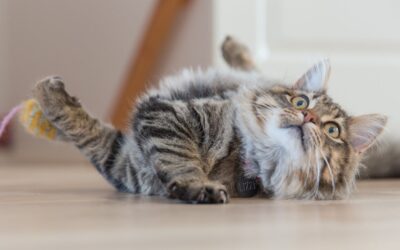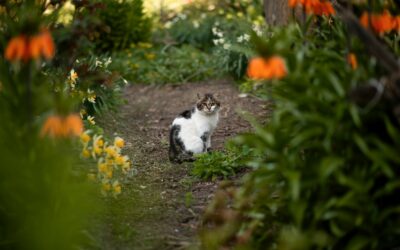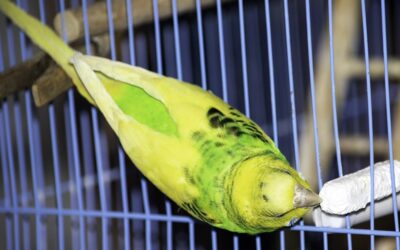Want to spruce up your interior with some greenery, but also have one or multiple furry friends running around the house? It’s important to choose houseplants that are safe for dogs or cats, because some of the most popular indoor plants are unfortunately also toxic. Our pets don’t know the difference between safe and unsafe plants, so it’s up to us to make sure we don’t bring any flora into our homes that might harm them.
The good news? You still have plenty to choose from. There are loads of houseplants that are safe for dogs and cats to be found in your local plant store or garden center! Below, you’ll find our 16 favorites, hand-picked for you by our very own houseplant expert.
16 Houseplants that are safe for dogs and cats
Did you know that in many cases, entire genera (group of closely related species) of plants are safe, not just specific species? These genera often include a bunch of different popular species, meaning you’ve got a bunch to choose from. In these cases, we’ll mention the most popular species in the genus for you to consider. These should be easy to find at your local plant store or online.
Let’s dive in!
Spider plant (Chlorophytum sp.)
Popular plants to choose from: Spider plant (Chlorophytum comosum), orange spider plant (Chlorophytum orchidastrum)
Difficulty level: Easy
Water: When the soil is halfway dry
Light: Bright indirect light
Soil: Well-draining
Notes: Some sources mention that the spider plant has a mild hallucinogenic effect on pets when ingested. However, we could find no actual scientific sources corroborating this or even discussing it at all. Sounds more like a persistent myth than anything else!

Pictured: Chlorophytum comosum, better known as the spider plant.
Prayer plants (Goeppertia, Calathea & Maranta)
Popular plants to choose from: Rose-painted prayer plant (Goeppertia roseopicta), rattlesnake plant (Goeppertia insignis), peacock plant (Goeppertia makoyana), Calathea orbifolia, zebra plant (Calathea zebrina), prayer plant (Maranta leuconeura)
Difficulty level: Intermediate to hard
Water: Keep lightly moist
Light: Bright indirect
Soil: Rich but well-draining
Notes: The common name “prayer plant” refers to a wide range of plant species. What they all have in common is that their leaves fold upwards at night, like folded hands in a prayer. They’re all spectacular, but known to be a little fussy.

Pictured: Goeppertia makoyana, better known as the peacock plant.
Areca palm (Dypsis lutescens)
Popular plants to choose from: Intermediate
Water: Keep lightly moist
Light: Bright, indirect light
Soil: Well-draining, but retaining some moisture
Notes: Some houseplant enthusiasts find Areca palms (also known as butterfly palms or bamboo palms) a breeze to grow, while others struggle with dying foliage and an unhappy plant. Low humidity is a common cause of a struggling Areca—the air moisture level should be 60% or up year-round.

Boston fern (Nephrolepis sp.)
Popular plants to choose from: Boston fern (Nephrolepis exaltata), Kimberly queen fern (Nephrolepis obliterata), fishtail fern (Nephrolepis falcata)
Difficulty level: Intermediate
Water: Keep moist
Light: Bright, indirect light
Soil: Rich, well-draining but retaining some moisture
Notes: Houseplant enthusiasts commonly struggle with leaf loss in their ferns. Lack of humidity and erratic watering (too much or too little) are common causes for a shedding fern.

Maidenhair fern (Adiantum sp.)
Popular plants to choose from: Delta maidenhair fern (Adiantum raddianum), northern maidenhair fern (Adiantum pedatum), Himalayan maidenhair fern (Adiantum venustum), etc.
Difficulty level: Hard
Water: Keep moist
Light: Bright, indirect light
Soil: Rich, well-draining but retaining some moisture
Notes: Although Adiantum ferns sometimes spontaneously pop up in rock cracks and on walls in nature, they’re not that easy to care for in the home. They need high humidity and moist but well-draining soil, and will quickly wilt if their needs aren’t met.

Bamboo palm (Chamaedorea sp.)
Popular plants to choose from: Parlor palm (Chamaedorea elegans), cat palm (Chamaedorea cataractarum)
Difficulty level: Intermediate
Water: Keep lightly moist
Light: Bright, indirect light
Soil: Well-draining
Notes: These low understory palms are popular as indoor plants thanks to their ability to withstand relatively low-light conditions.

African violet (Streptocarpus sp., formerly Saintpaulia)
Popular plants to choose from: Many, many different selectively cultivated varieties. Pick whichever you like!
Difficulty level: Intermediate
Water: Keep lightly moist, don’t wet the leaves
Light: Bright indirect light
Soil: Commercial African violet mix
Notes: The genus Streptocarpus, to which African violets now belong, has many more pretty plants to choose from. Our favorite is Streptocarpus ‘Pretty Turtle’, which is indeed gorgeous to look at!

Cast iron plant (Aspidistra eliator)
Difficulty level: Easy
Water: Let the soil dry halfway
Light: Bright indirect, also does well in low-light conditions
Soil: Well-draining
Notes: Known as a nearly indestructible houseplant, the cast iron plant is one of the best options on this list if you’re a beginner looking to add some (pet-safe) greenery to their home.

Radiator plant (Peperomia)
Popular plants to choose from: Baby rubber plant (Peperomia obtusifolia), watermelon Peperomia (Peperomia argyreia), emerald ripple Peperomia (Peperomia caperata), etc.
Difficulty level: Easy to intermediate
Water: Let the first 2″ of soil dry out
Light: Bright, indirect light.
Soil: Well-draining
Notes: Radiator plants are known for their pretty colors, funky textures, and the ability to regrow from a single leaf. Unlimited propagation!

Bromeliads (family Bromeliaceae)
Popular plants to choose from: Loads! Air plants (genus Tillandsia), genus Guzmania, genus Neoregalia, genus Vriesea, etc.
Difficulty level: Easy to intermediate
Water: Keep the central cup filled. For air plants (Tillandsia), soak regularly
Light: Bright, indirect light
Soil: Fine orchid bark with sphagnum moss. For air plants, no soil at all
Notes: Bromeliads are oddities in the plant world, with most naturally growing on trees. They’re appreciated for their amazing blooms, but do come with some special care guidelines.

Orchids (family Orchidaceae)
Popular plants to choose from: So many! Moth orchid (genus Phalaenopsis), Dendrobium nobile, genus Cattleya, dancing lady orchid (genus Oncidium), slipper orchid (genus Paphiopedilum), etc.
Difficulty level: Intermediate to hard
Water: Soak regularly
Light: Bright, indirect light
Soil: Orchid bark
Notes: Orchids can be fussy, although they’re not too difficult once you understand their needs. The species mentioned here are intermediate in difficulty; if you don’t have much experience, it’s best to pick one of these to start with.

Money tree (Pachira aquatica)
Difficulty level: Easy
Water: Let the top 2-4″ of soil dry out
Light: Bright, indirect light
Soil: Well-draining
Notes: We think the money tree is an excellent alternative for the umbrella tree (genus Schefflera), which is more difficult to care for and unsafe to grow around pets due to its toxicity.

Friendship plant (Pilea sp.)
Popular plants to choose from: Chinese money plant (Pilea peperomioides), silver sparkle plant (Pilea glauca), aluminum plant (Pilea cadierei), friendship plant (Pilea involucrata), etc.
Difficulty level: Easy to intermediate
Water: Keep lightly moist
Light: Bright, indirect light
Soil: Rich but well-draining
Notes: The Chinese money plant, P. peperomioides, experienced a massive surge in popularity in the 2010s thanks to its ability to grow an army of baby plants. Pass them on and spread the (pet-safe) houseplant love!

Mosaic plant (Fittonia albivensis)
Difficulty level: Hard
Water: Keep moist
Light: Bright indirect light
Soil: Rich but well-draining
Notes: Quite fussy about (air) moisture levels, the mosaic plant is an excellent candidate for growing in a plant terrarium.

Polka dot plant (Hypoestes phyllostachya)
Difficulty level: Hard
Water: Keep moist
Light: Bright, indirect light
Soil: Rich but well-draining
Notes: This beauty is available in different colors. Beware, though: it will quickly suffer is (air) moisture is lacking. It’s also prone to growing leggy.

Holiday cacti (Schlumbergera sp.)
Popular plants to choose from: Christmas cactus (Schlumbergera × buckleyi), Thanksgiving cactus (Schlumbergera truncata), Easter cactus (Schlumbergera gaertneri)
Difficulty level: Easy to intermediate
Water: Let the soil dry halfway
Light: Bright, indirect light
Soil: Well-draining
Notes: These are jungle cacti that don’t like to be treated like their desert cousins. Their care is more similar to that of tropical houseplants, so don’t let yours dry out for weeks on end!

To keep in mind
Before we wrap up this post, we’d like to remind you that it’s always best to keep plants out of your pets’ reach. Even with houseplants that are safe for dogs and cats, like the ones discussed here, ingestion can give your furry friend an upset tummy. There won’t be any serious issues, as the plants on this list are 100% non-toxic, but your pet’s body isn’t made for digesting them either! If it nibbles on them, some mild vomiting or diarrhea can occur. Keep an eye on your dog or cat and offer plenty of water.
Additionally, of course, most houseplants don’t appreciate being chewed on either. As such, it’s best to keep the animals and plants in your home separated as much as possible! Try hanging planters or place your greenery higher up in places your pet can’t get to them.
PS: Wondering if a plant is safe? The ASPCA website is a great resource that lists the toxicity for loads of (house)plant species.






